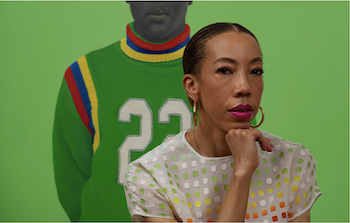
Amy Sherald was born in Columbus, Georgia on August 30, 1973 to father Amos P. Sherald III and mother Geraldine W. Sherald. Sherald grew up with siblings Harriet Sherald and Michael Sherald. Ever since she was young, Sherald has always been fascinated about drawing and creating art. In an interview with Paulette Beete for The Colossal, Sherald recalls her perfectionist tendencies for art when she was around five or six years old. Therefore, she wanted to create masterpieces even as a child, and her self-critical mindset stuck with her for the rest of her life. In her early childhood, Sherald spent most of her days playing basketball, hiking, and building items such as tables from wood.
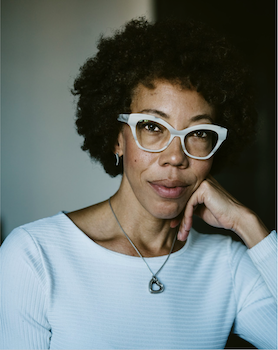
In 1997, after graduating high school, Sherald attended the Clark-Atlanta University as an undergraduate on the pre-med track. She soon realized that a path in science was not for her, and she changed to study painting with the help of painting instructor Dr. Arturo Lindsay. Despite the immense pressure from Sherald’s parents to pursue a career in medicine, Sherald found her calling in art. After earning her BA in painting from the Clark-Atlanta University, Sherald received her MFA in painting from the Maryland Institute College of Art in 2004. After she finished her MFA, Sherald studied under painter Odd Nerdrum at his property in Larvik, Norway.
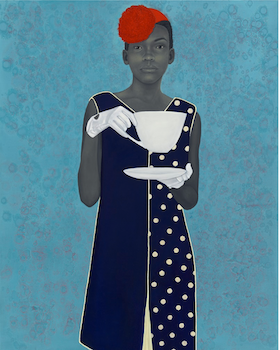
In 2004, Sherald was unexpectedly diagnosed with cardiomyopathy, a heart disease that makes it harder for the heart to deliver blood to the body, right before running a triathlon she had been training for. She had dreamed of finishing a marathon, and not only did her new condition stop her from fulfilling this dream, but it also limited and drained her energy to paint. Furthermore, Sherald would eventually have to wait tables five days a week to pay for treatment. Eventually, she had to move back to Georgia to care for her aunts, mother, and brother, who was diagnosed with stage 4 lung cancer. In 2008, Sherald moved back to Baltimore, Maryland to focus on her work, and she began to gain recognition for a piece acquired by the National Museum of Women in the Arts. However, in 2012, while shopping at Rite-Aid, Sherald collapsed and blacked out. She was rushed to the Johns Hopkins Hospital, where she waited two months for a heart transplant. While it took time to receive a transplant, her recovery required her to stop painting for about a year. Although her journey to survive through her heart conditions was difficult, her perseverance during this time in her life was reflected in her ability to keep painting: fighting for both herself and for her fellow African Americans.
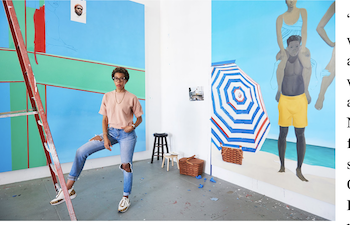
Sherald’s artwork was gaining recognition during the late 2010s because of her impressive use of grisaille, a style of monochromatic painting that uses shades of gray, and her contemporary subjects. Sherald painted everyday African Americans in a modern setting with gray-toned skin. She used grisaille to make a gray tone to challenge the relationship between color and race. Sherald’s fame exploded in 2016 when she was the first woman and the first African American to win the National Portrait Gallery’s Outwin Boochever Portrait Competition, along with a $25,000 reward. The art piece that won was a painting called Miss Everything (Unsuppressed Deliverance), which was based on a photograph of a friend. In the painting, a woman wearing a vintage dress and a red hat holds an oversized teacup above her head. In addition, the painting was inspired by the film Alice in Wonderland, and it urged the audience to look beyond just the skin color of the subject.
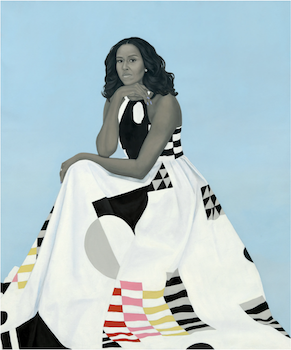
In 2017, Sherald won the “Anonymous Was A Woman” award, which recognizes exceptional female artists based on their career and previous works. That same year, she was selected as one of the “19 Artists to Watch” by the New York Times. However, Sherald’s famous win was in 2018 when she was selected to paint former Michelle Obama’s official portrait for the National Portrait Gallery in Washington D.C. In her portrait, Michelle Obama looks regal in a dress with a traditional African American quilting pattern with modernist abstractions of Piet Mondrian against a blue background. In 2019, Sherald’s new solo exhibition was featured at Hauser & Wirth in New York City. Titled the heart of the matter…, Sherald’s exhibition focused on paintings of young, anonymous African Americans based on photographs. In December 2020, Sherald’s piece The Bathers, originally painted in 2015, sold for $4.2 million at the Phillips' Evening Sale of 20th Century & Contemporary Art.
Today, the artist continues to work and live in Baltimore with her partner, Kevin Pemberton. Her works continue to be held in the Nasher Museum of Art at Duke University, the Smithsonian National Portrait Gallery in Washington D.C., the Whitney Museum of National Art in New York City, the Los Angeles County Museum of Art, the Embassy of the United States, Dakar, Senegal, and the Museum of Fine Arts Boston.Sherald’s contribution to the art world has been immense, especially for other African Americans and women. Sherald’s portraits give her the ability to create a narrative, share her voice, and tell the story of African Americans. There are times when her identity is necessary to bring to the conversation, especially when acknowledging representation and the social justice issues in her works. Other times, we are urged to look beyond just an identity and see art as something more. It is her contribution as an artist and an African American woman, both separately and together, that is inspiring to all. Furthermore, her artwork is also a great place for self-reflection, specifically with the large focus on the people in her pieces rather than the background or other props. Painting acts as a resting place for Sherald, and a place to let out all of her imagination and hope for the world. This hope and imagination is inspiring to all who find it in her work.
Why Did I Choose to Research Amy Sherald?
I chose to research Amy Sherald because of my personal connection to her mission and advocacy work. As a fellow person of color with a liking towards art and writing, Sherald both challenges and inspires me to see how I can incorporate my own Asian American background into my work. Looking at her art pieces allows me to reflect and remind myself of the numerous injustices that exist in the world, both related and unrelated to race, and how I can educate myself even further. I also really understand her struggles with a lack of representation for African Americans. Especially in the art world, I find that there are very few Asian Americans. This is why I resonate so much with her wanting to increase the diversity and representation in the industry.
Her art itself is beautiful and thought-provoking as well. The way that she uses grisaille is so interesting and unique. The vibrancy and intricacy of the clothes that her subjects wear really contrast the grisaille and the pastel backgrounds that she paints. I also enjoy how contemporary her art is. She is able to focus on modern day people and issues that I could see in my own life. While it’s obvious that most of these subjects are posing for the art, Sherald is still able to create a natural feeling to the environments and people that I find to be hard to find in modern artworks.
Works Cited
Amy Sherald. Hauser & Wirth. (n.d.). https://www.hauserwirth.com/artists/11577-amy-sherald/
Amy Sherald. High Museum of Art. (2024, March 7). https://high.org/driskell-prize/amy-sherald/
SisumD. (2018, June 13). Former first lady, Michelle Obama by artist Amy Sherald. National Portrait Gallery. https://npg.si.edu/Michelle_Obama
Swenson, K. (n.d.). Who is Amy Sherald? the artist behind Michelle Obama’s portrait - The Washington Post. https://www.washingtonpost.com/news/morning-mix/wp/2018/02/13/the-life-and-near-death-of-michelle-obama-portrait-artist-amy-sherald/
This article was published on 8/7/24